The stock market is a forward-looking indicator that gauges the health and future growth of an economy.
In other words, if an economy is expected to grow, then the stock market should rise.
That is what the world believes. And if you believe something to be true, then that something becomes reality.
So let’s look at our world from another perspective.
What if we inverse the relationship between the stock market and the economy?
What if the stock market dictates the future of the economy, instead of the economy dictating the pace of the stock market?
A self-fulfilling prophecy, so to speak.
If that were the case, then manipulating the future of our economy would be as simple as, well, manipulating the stock market.
And that is precisely what central bankers are doing.
Japan Manipulates its Future
It seems that no matter how much money Japan throws at its economy through central bank stimulus, it just can’t seem to achieve its target inflation of 2%.
This Friday, Japan once again unleashed its stimulus and media outlets were filled with headlines about Japan’s surprising increase in central bank stimulus.
Here are just some of the headlines:
Japan’s Central Bank Shocks Markets with More Easing as Inflation Slows
Bank of Japan Unexpectedly Moves to Stimulate Economy
Bank of Japan Stuns Market with Even More Stimulus
Via Reuters:
“The central bank also said it would triple its purchases of exchange-traded funds (ETFs) and real-estate investment trusts (REITs) and buy longer-dated debt, sending Tokyo shares soaring and prompting a sharp sell-off in the yen.”
Almost every article on Japan’s added stimulus portrays the stimulus as something that was unexpected.
But if you have been following this Letter for some time, Japan’s newly announced stimulus would not have been a surprise at all.
Here’s an excerpt from my Letter, “How the Fed Influences the Stock Market“:
“Just this week (July 13, 2014), Bloomberg revealed that the Bank of Japan (BOJ) is now preparing once again to buy exchange-traded funds based on the JPX-Nikkei Index 400* as an “option to boost the impact of unprecedented easing and encourage companies to deploy cash for investment.”
*Note: The Nikkei 225 is comprised of the top 225 public companies in Japan; it is essentially Japan’s Dow Jones. The Nikkei 400 is comprised of the top 400 companies in Japan. In other words, the BOJ will be investing in even higher risk companies.
Recall Japan’s massive and ridiculous amount of stimulus to spur inflation to at least 2% – a difficult feat considering that the country has been in a deflationary state for most of the last 20 years.
In May, Japan announced that the nationwide consumer inflation rate accelerated to 3.7 percent in May from 3.4 percent in April, the fastest rise in 30 years.
This was expected with the record amount of stimulus launched last year.
However, core inflation – the BOJ’s preferred gauge – is expected to slow back to around 1%.
That means Japanese consumers are now forced to pay more for things as their currency continues to be devalued, while wages have yet to increase. This will once again lead to a slow-down in real economic growth.
The only way for the citizens of Japan to keep up is to take on more risk and invest in the stock market (precisely what the BOJ wants them to do).
The reality is simple: Japan’s central bank will have no choice but to print more money to meet its target of 2%. That means we’ll likely see further purchases of stock to boost the market as well as other forms of stimulus.
So, while many financial journalists continue to talk about bubbles (one which I agree is happening), it may not be ready to pop just yet.
In March of last year, I told readers to front-run the BOJ and borrow yen to buy Japanese stocks.
The Nikkei, despite a pullback earlier this year, is still up over 20%.
Perhaps its time to front-run the BOJ again.”
Here’s a look at what happened to the Nikkei in just a few short months since March of 2013:
Here’s a look at what happened from June 13, 2014, as I mentioned above, “Perhaps its time to front-run the BOJ again”:

Then on August 17, 2014, I wrote:
“As I mentioned inmany past letters, front-running the Bank of Japan is a great way to make some profits.
But now that the BOJ has stepped in, we should be a little more weary of the profits that have been made leading up to the BOJ’s stock purchases:
Via WSJ:
“Through a trustee, the (Bank of Japan) purchased a combined ¥92.4 billion ($904.2 million) in ETFs over the first six business days of August. That’s the BOJ’s longest and largest consecutive buying streak since it started purchasing ETFs in December 2010.”
The BOJ has said it plans to increase its ETF holdings to ¥3.5 trillion by the end of this year. As of Aug. 10, it held ¥3.122 trillion.
This means the BOJ’s market support could soon end. If it does, shares could drop.
That is, unless, the central bank announces further purchases…”
Here’s a look at what happened to the Nikkei shortly after the BOJ left the market:
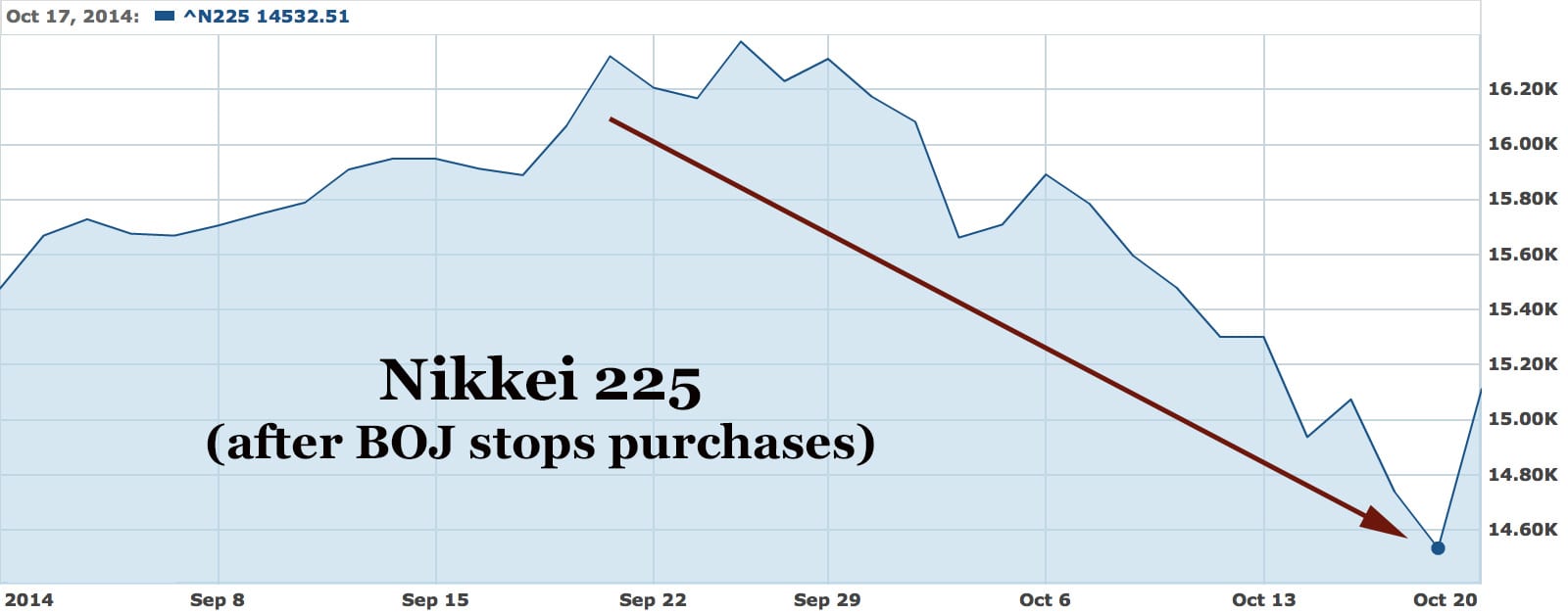
After the mass amount of stimulus already unleashed by the BOJ, there’s no way the central bank would let its stock market collapse; after all, the stock market now dictates the pace of the economy.
So, exactly as I predicted, “…This means the BOJ’s market support could soon end (which it did). If it does, shares could drop (which it did)…That is, unless, the central bank announces further purchases…(which it has just done).”
In another front-running the BOJ trade, you can clearly see that “someone” knew that the central bank was about to announce yet another bout of stimulus. Here’s another look at the Nikkei a week before the announcement:
Here’s the last five trading days, including the spike right after the BOJ’s stimulus announcement Friday:
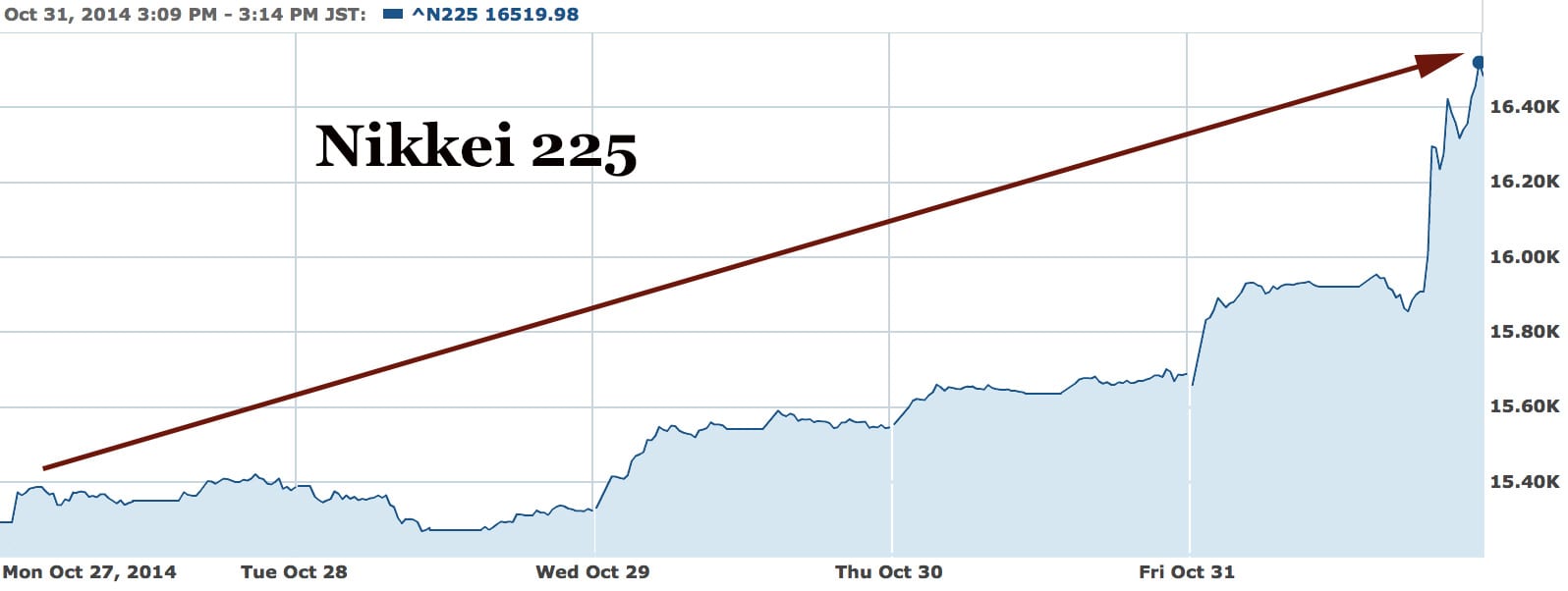 The only ones shocked about the BOJ stimulus were, once again, the media and all of its gullible followers.
The only ones shocked about the BOJ stimulus were, once again, the media and all of its gullible followers.
The Biggest Buyer of Garbage Round Two
I’ve discussed many times that the Fed has been the biggest buyer of US debt since 2008.
The BOJ is expected to buy 8 trillion to 12 trillion yen ($108 billion) of Japanese government bonds per month.
Japans’ Ministry of Finance is projected to sell the 10 trillion yen in new bonds every month.
Know what that means?
Yup, the BOJ could likely end up buying all of the newly issued government bonds.
Via Bloomberg:
“The Bank of Japan’s expansion of record stimulus today may see it buy every new bond the government issues.
The BOJ said it plans to buy 8 trillion to 12 trillion yen ($108 billion) of Japanese government bonds per month under stepped-up stimulus it announced today. That gives Governor Haruhiko Kuroda leeway to soak up the 10 trillion yen in new bonds that the Ministry of Finance sells in the market each month.
The central bank is already the largest single holder of Japan’s bonds, and the scale of its buying could fuel concerns it is underwriting deficits of a nation with the heaviest debt burden. The BOJ could end up owning half of the JGB market by as early as
in2018, according to Takuji Okubo, chief economist at Japan Macro Advisors in Tokyo.”
The Biggest Buyers of Japanese Stocks
But that’s not all the BOJ is buying.
As I mentioned before, the BOJ has stepped in and is now directly buying Japanese stocks.
So much so that it is now the second-biggest shareholder of Japanese stocks – second only behind the Government Pension Investment Fund.
And that’s not about to change anytime soon.
That’s because in conjunction with the BOJ stimulus, Japan’s national pension fund, the largest in the world, just announced that it would double its holdings of foreign and domestic stocks.
Via WSJ:
“Japan’s $1.2 trillion public pension fund said Friday it plans to take more aggressive bets by slashing how much money it puts in domestic bonds and ramping up its investments in stocks.
…Under the new allocation guidelines, Japanese stocks and foreign stocks will each take up 25% of the fund’s holdings, up from 12% each previously. The fund intends to put 35% of its money in domestic bonds, down from 60%, while the ratio for overseas bonds will rise to 15% from 11%.”
Once this allocation occurs, Japan’s government pension investment fund will have half of its money in stocks.
In other words, Japan wants others to invest in its stocks and is leading by example.
If stocks collapse, Japan is doomed.
Why?
Because if you recall from my Letter, How Russia is Working with China:
“Japan is a nation with a stagnating economy, a deficit over 9% of GDP, and an expected public debt this year of 242 percent of GDP.
Over the next 20 years, Japan’s work force is expected to fall from 70% to 55%, while those over 65 already represent more than 20% of its population.
Sales of adult diapers already exceed those made for babies.”
Simply put, Japan’s version of social security now rests in the hands of the stock market.
If the stock market crashes, well…bye-bye pensions, it was nice knowing ya…
Is Japan Secretly Working with the US?
Is it a coincidence, or an agreement between two nations, that a day after the end of US’ QE program, Japan announces yet another “surprise” increase in added stimulus, sending both U.S and Japanese stocks higher?
Is it a coincidence that the US has accused other countries, such as China, with currency manipulation, but has never accused Japan who has unleashed more QE per GDP than any other developed country in the world?
Remember, the US is Japan’s ultimate nuclear protector and Japan is the world’s third largest holder of US debt (third only to China and the Fed).
The use of monetary inflation by the US has already fueled massive controversy with both Western and Eastern regimes. In particular, it has already added consequential damage to China.
With the addition of Japan’s newly announced stimulus, you can bet the Asian currency market will feel substantial shocks and create serious tensions between countries such as China and Korea.
Recall the Asian financial crisis between 1997-1998, which raised fears of a worldwide economic meltdown due to financial contagion.
In 1998, the Yen’s sharp devaluation led to a very dangerous currency war episode between Japan and China, where China threatened to retaliate. If China had carried out its threats, it would have led to a major disintegration of the financial trade system in Asia.
The yen’s fall in 1998 also shocked Wall Street, which prompted the US Treasury and Federal Reserve to intervene to prop up the yen.
However, this time things are different.
Unlike 1998, the US appears to be in support of Japan’s stimulus and devaluation, with US markets soaring on the BOJ’s announcement.
Japan is now at the epicentre of a currency maelstrom, thanks to its recent stimulus.
On Friday, the yen plunged to a near seven-year low against the US dollar, putting it on track for its worst day in 18 months.
This currency devaluation will undoubtedly send shocks in the Asian market, potentially leading to a more tumultuous replay of the 1997-1998 Asian financial crisis.
China is already facing both a credit and liquidity crunch, with foreign direct investments into the country already turning negative.
China will feel the effects of Japan’s currency devaluation and it will take action.
Let’s not forget that China’s growth is a threat to the US, while its relationship with Japan has never been amicable.
Could the US and Japan be working together in this round of currency wars?
Prepare for the currency wars to heat up.
I’ll go into further details on the current state of currency wars in the next installment of the Equedia Letter.
Stay tuned…
Be sure to share this with everyone: http://equedia.com/japan-secretly-working-with-united-states
Until next time,
Ivan Lo
The Equedia Letter


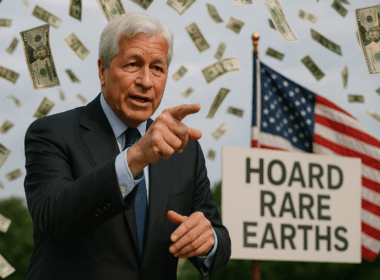




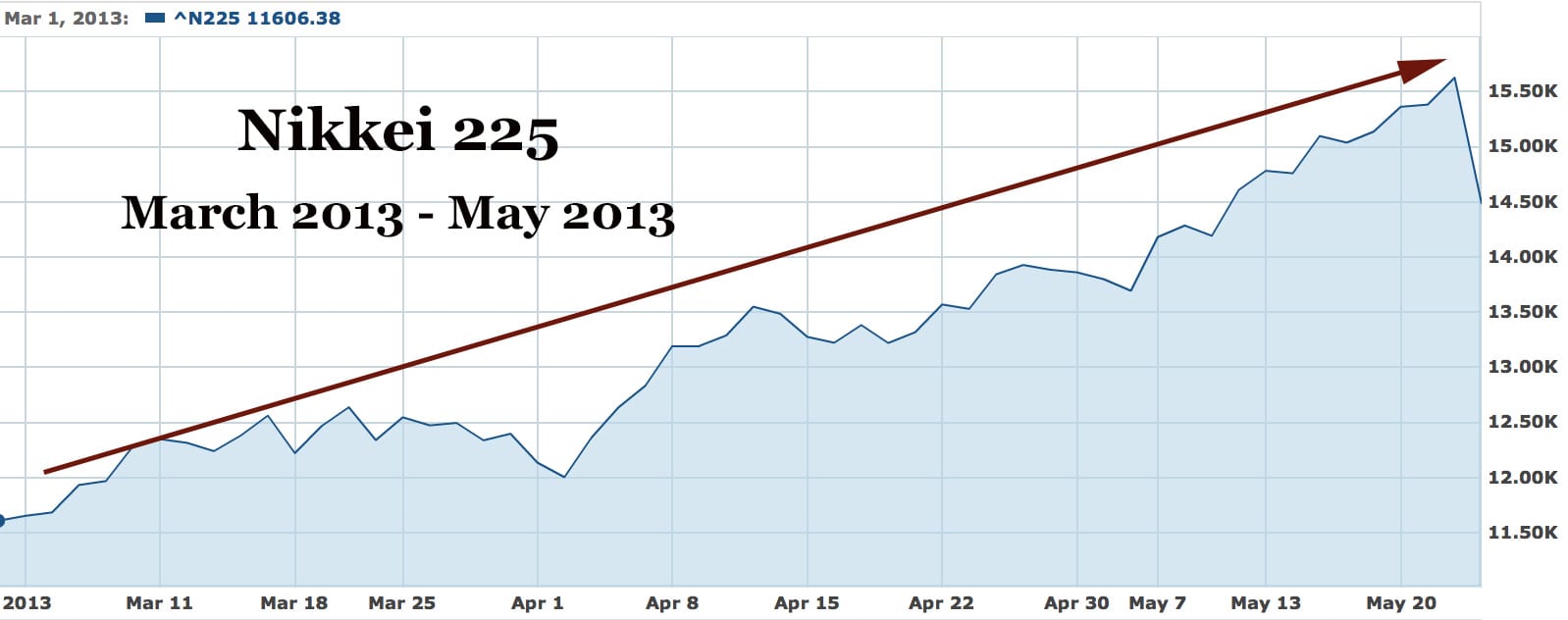


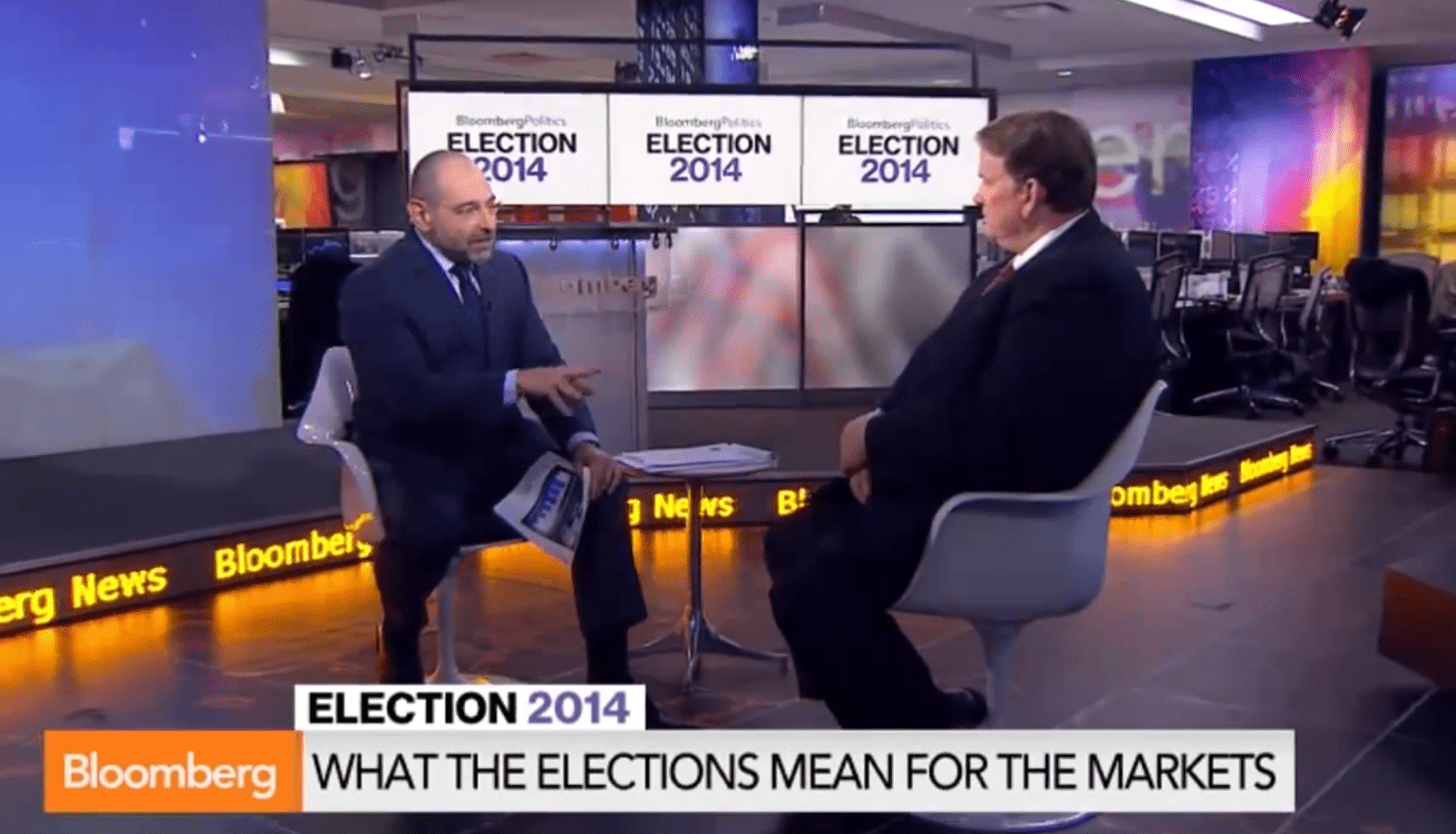
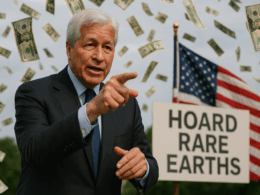



I Have no Idee.
fantastic view point.
Fiat currencies and debt are the biggest bubble currently.When they go into freefall ,the whole central bank game,of printing to stimulate economies, is over.
Japan’s quantitative easing was a natural consequence of rise of the YEN in the 80’s and subsequent negative effect on its economy.
Recently with the US printing money (electronically) with quantitative easing, Japan could simply not compete but as soon as the US ended its printing money, Japan seized the opportunity to resume its printing of YEN.
Saying that Japan and the US are in a conspiracy together as allies is comparable to saying China and the US are in a conspiracy together as enemies rather than all opportunists in the realm of international finance.